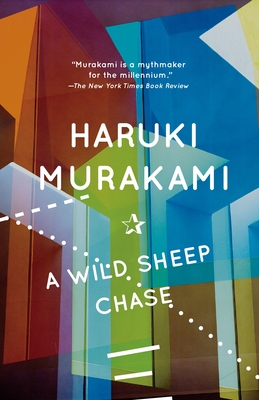A Wild Sheep Chase
Haruki Murakami

I was surprised at how much I liked this book–I nearly gave it four stars. The reason I picked it up was basically a Murakami-completist urge: since I consider him to be my favorite author right now, I figured I should read everything he’s written. (I’m now pretty close–“Hard-Boiled Wonderland and the End of the World” is the only novel of his that’s widely available in English that I still haven’t read.) I started out somewhat biased against it, because “Dance Dance Dance” is my least favorite of his novels thus far, and I guessed that some of the elements of that book, such as the Sheep Man, would probably figure into this one. I was right that they would figure in, but the book ended up being much more enjoyable for me than “Dance Dance Dance”.
AWSC consistently put me in mind of two major literary influences: Kafka and Pynchon. I’ll start by saying that I have read a lot of Kafka and really like him, but I have only read “The Crying of Lot 49” by Pynchon and seriously disliked it (I had to read it for a class). But I found both influences to be enjoyable in AWSC.
First, Kafka. It is no secret that Murakami has an affinity for Kafka and references him more or less explicitly in many of his works. The plot of AWSC has a clear structural similarity to “The Trial”, in which the protagonist is inexplicably thrown into the machinations of some shadowy larger organization, and finds himself threatened by it and having to play by its rules. (This atmosphere arises in other works of his, for example his short story “Dabchick”.) But more than that, Murakami also consciously emulates the bizarre and obfuscatory bureaucratic language that Kafka uses to emphasize the maddening aspects of a faceless organization. In AWSC, the protagonist’s conversations with the Boss’s secretary are a fantastic example of this.
Second, Pynchon. The bizarre sheep-centric cult-ish story that unfolds reminded me a lot of the Thurn und Taxis/Trystero storyline in Lot 49, as an absurdist conspiracy that is intended to look totally silly but has to be taken seriously by the book’s characters. Both have a sort of madcap style where the sheer weirdness is an important component that the author seems to revel in, but I felt like in AWSC it was toned down to a level where I actually enjoyed it, whereas in Lot 49 it dominated all the other parts of the story. Another example of this sort of atmosphere that I actually enjoyed is the “Luisa Rey” section of David Mitchell’s “Cloud Atlas”.
AWSC combines these elements with many of the traditional Murakami concerns–the nature of a solitary life, the loss of a romantic partner, the search for anchorage to one’s life. (One of the book’s scenes is also clearly built out of his short story “The Mirror”.) I think Murakami’s best work matches these aspects with an equal measure of fun or even silliness–in this category I would include The Wind Up Bird Chronicle, Kafka On The Shore, and this book, as well as many of his short stories. The second tier of his works for me, though I still really like them, fall a little short because loneliness and sense of loss are not well-balanced by a sense of fun–in this category I would include Norwegian Wood, Sputnik Sweetheart, Dance Dance Dance, and South Of The Border West Of The Sun. I imagine that “Hard Boiled Wonderland” will also fall into the first category, so I’m excited to read that!
The reason I ultimately decided not to give it four stars, though, is that I thought the emotional themes were not as well developed as in some of his other works. This makes sense given that AWSC was a very early work (1982) and he has returned to these themes over and over again, refining them and portraying them more successfully in his more recent novels.